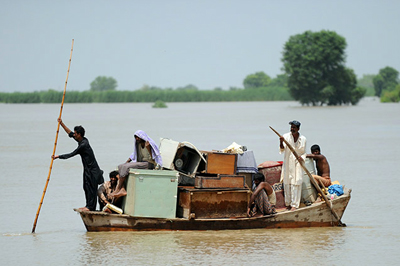

Photography via the Guardian

The summer monsoon rains arrived in Pakistan last month. And with one-fifth of the country now submerged, they have yet to stop. The rain continues to fall and the flood waters keep rising, making for a waterlogged crisis of Biblical proportions: an estimated 1,600 Pakistanis are dead, but that figure only begins to hint at the disaster’s scale, as 20 million have been displaced, according to the country’s prime minister. All of this adds up to the region’s worst flood in eight decades.
For a nation already afflicted by widespread poverty and with half of its labor force devoted to agriculture, the months ahead will be extremely trying now that 17 million acres of farmland are under water and 200,000 head of livestock have been lost. The extended food shortages resulting from this situation will require generous donations of international aid, but so far the world has been slow to respond. As of last Tuesday, less than 40% of the U.N.’s requested $459 million in relief funds had been made available (though an additional $43 million had been pledged). The United States has been chief among the countries responding to the disaster, but aid organizations have been reporting donor fatigue in the wake of the tremendous outpouring of funds after the Haitian earthquake earlier this year. In a time of economic hardships across the globe, we may be seeing evidence of limits to generosity and of public weariness at the prospect of managing the fallout from yet another catastrophe in a remote corner of the world. But the disaster’s proximity to other calamitous events makes it no less severe.




 Facebook
Facebook Permalink
Permalink Digg
Digg Reddit
Reddit LinkedIn
LinkedIn StumbleUpon
StumbleUpon Tumblr
Tumblr

